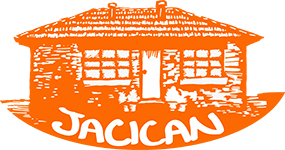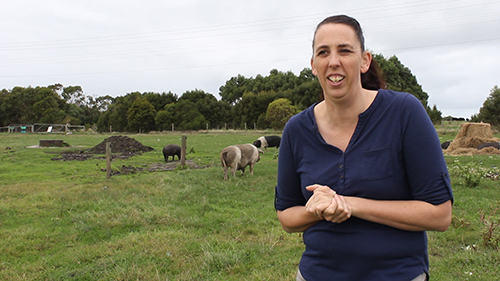When we first brought our property that was to become Jacican, there were only three fruit trees.
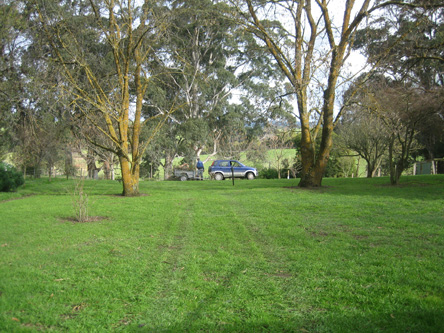
The kitchen garden when we first brought the property in 2008
Before us, there were rumours that the ¾ acre property had a full self-sufficient garden, but the previous owner had mown over it over 20 years, and there was very little left.
One ancient plum tree, an apple, and an ornamental peach – that was it.
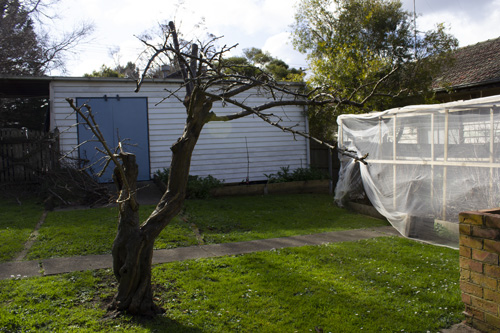
The ancient plum tree - one of the original three fruit trees at Jacican
Over the 13 years we have been living here, there are now three apples, three hazelnuts, a feijoa, a medlar, seven citrus, two mulberries, a quince, three babacos, a pear, three peaches, two apricots, a nectarine, a cherry, two figs, a new plum, and the old plum.
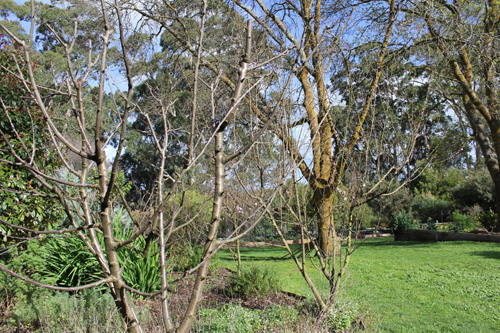
Fruit tree - bare of leaves - waiting for a winter prune
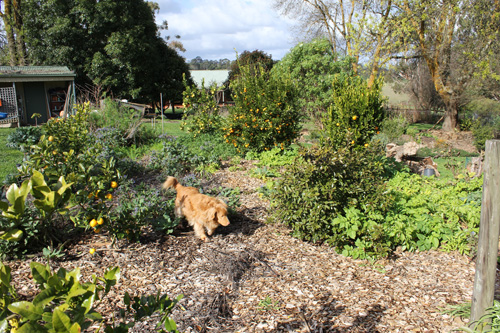
Seven different citrus fruit trees are now in the Jacican Kitchen garden
Along with currents, raspberries, strawberries, edible natives, herbs, passionfruit, flowers, and annual and perennial vegetables.
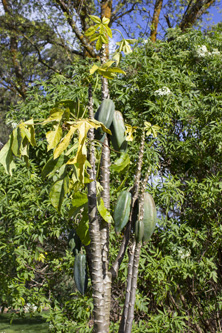
Babacos - also called champagne fruit
You can see the change.
We learned how to look after the fruit trees.
When they needed to be pruned, prune them with what, when, and where on the tree.
And we are still learning …
If you would like to learn to we are running a winter pruning class on Saturday 7th of August 2021.
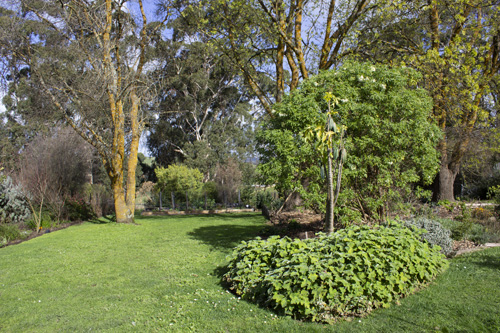
The kitchen garden at Jacican in 2021.
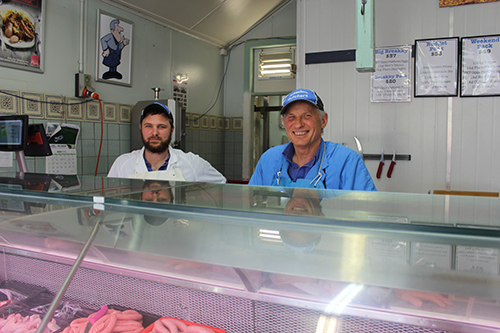
Third and second-generation butchers, Matthew and Neville Vaux, Rosedale butchers. Photo Jaci Hicken
At lunch, Susan is telling a story about how the bacon she is eating tastes like the bacon she had when she first moved from the UK to Rosedale, Gippsland, in 1982. The answer is, "it is, it is the same bacon."
It's not possible that its precisely the same bacon, but it is still made by the Vaux family in the same butcher's shop, using the same method, recipe and wood smokehouse, but now by the second and third-generation butcher.
Neville Vaux, his wife Debbie and their son Matthew run Rosedale butchers, on the highway in Rosedale, Gippsland.
"We came here in 1977, then I did my apprenticeship with Mum and Dad. Debbie and I brought the shop in 1995. In 1997 Matthew came along and in 2007, he started his apprenticeship with us." Neville said.
The reason Susan thought the bacon tasted the same, from when she first moved to Rosedale, is the family still operates the smokehouse installed by Neville's father, Raymond Vaux.
"We still use the smokehouse installed by Dad's father in 82, which aren't fancy. We use them to make all our small goods and bacon," Mathew Vaux said.
For the smoking process, carried out by Matthew, fresh forequarter, legs or loins of pork are pickled, injected with water and a salt, herb and spices mix. It is then cured in a pickling tub containing a brine of salt solution and water.
After three days in the pickling tub, the pork is washed off and smoked anywhere from 14 to 18 hours. This becomes the ham or bacon that Susan remembers from 1982.
"It's exactly the same process from 1982," Matthew said.
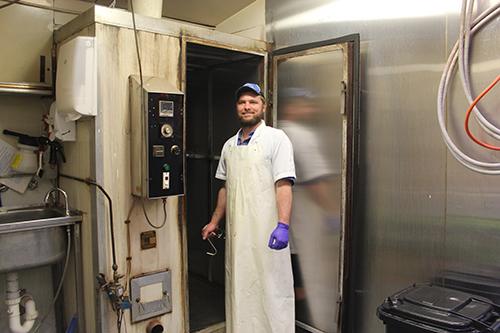
Matthew Vaux, Rosedale butchers with the families smokehouse in use on the premise since 1982. Photo Jaci Hicken
The butcher's shop and the attached house next door has been in the same place in Rosedale since the late 1800s. Before Raymond Vaux built the smokehouse to meet regulations, the fireplace was in the kitchen in the shop, "and they use to have rails above the fireplace. That was how originally the hams were smoked," he said.
Traditional smokehouses are run on a wood fire. To meet regulations set by PrimeSafe, the smokehouse at Rosedale butchers is run on gas that burns food-grade wood chips to produce the smoke.
Wattlebank Park Farm free-range pig farmer, Nadine Verboon uses Rosedale butchers to cut and pack her pork products, firstly for personal use, then for the last seven years as the maker of small goods for her on-farm butcher's shop.
Nadine Verboon, Wattlebank Park Farm with her pigs. Photo Jaci Hicken
Using pigs that are raised at Wattlebank Park farm, Rosedale butchers make traditionally smoked bacon, cabana and polish sausage, that Nadine sells at Farmer's markets, online and through her butcher's shop.
"Rosedale does all our smoked small goods. We've been with Rosedale for probably 14 years," Nadine said.
Wattlebank Park farm runs saddleback and large black pigs and is currently trialling a Durco boar over their sows to breed to "get bigger hams."
"We are trying to keep those heritage breeds going. And the flavour that comes from them is just a phenomenal, beautiful flavour," Nadine said.
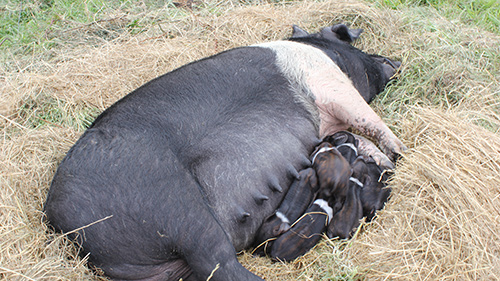
Saddleback sow and piglets at Wattlebank Park Farm. Photo Jaci Hicken
At Rosedale butcher, they are finding that there is a move towards the old English breeds of pig, like the heritage breeds at Wattlebank Park farm.
"They are fatter, but you can also get some mix breeds that come out with plenty of flavour," Matthew said.
"The quality of the product that comes in is the quality of the product that goes out. You can't go making gold out of bronze. To get a good quality product, you can have as big as you like, but as long as it's lean," he said.
Neville Vaux finds the quality of the pork depends on what feed the farmers give to their pigs.
"They don't give them the right grain, because the grain costs too much money, so they skimp on that. Then they give the pigs too much whey and that makes them fat. Then they give them too much bread, which makes them fat as well," Neville said.
"And too many vegetables makes them lean. We find that Nadine's pigs are lean," he said.
Only farming pigs for personal use, Caroline Van Oosterom recognises that you have to feed pigs feed with the "right animal protein percentage."
"The amount of protein you feed them is so important. Pigs need to have a feed that is high in lysine as a source of protein," Caroline said.
"We have taken the decision not to farm pigs commercially, only raise them for personal use, due to only being two abattoirs we can access, from Gippsland," she said.
The two licensed abattoirs that can take pigs are in Laverton on the west side of Melbourne and Orbost in far East Gippsland.
Wattlebank Park Farm transports their pigs to the city, which are then returned slaughtered to Rosedale butchers. Rosedale butchers will know which pig carcasses belong to Wattlebank Park farm, by the pig tattoo number on the right shoulder of the animal. Pigs are not allowed to leave a farm without this identification.
Rosedale butchers then cuts, process and packs a farmer's pork into any cut they would like. The fresh cuts that can be included are roast, chops, schnitzels, mince and sausages, and small goods, Matthew Vaux said.
Watch as Rosedale butchers fill and twist fresh sausages. Video Jaci Hicken
"Everyone’s product comes in different shapes and forms. There is always something you can do with it. It's just a matter of working out what cuts you require and what product you are going to get back," he said.
"You've just got to work in with your butcher. Your butcher is your end product and the more you work with the butcher, the happier the butcher will be working with your product."
Visit Wattlebank Park farm with Jaci. Video Jacican
Just outside Mirboo North, at Milly & P’lette farm cottage you will find Mary Germano Smeriglio. Mary has always cooked and shared things we may have thought where weeds for her family. Learning from her mother, Mrs. Paolina Germano, at an early age, Mary’s recipe for Cosce Vecchie has now been past on to her daughters, as well as me.
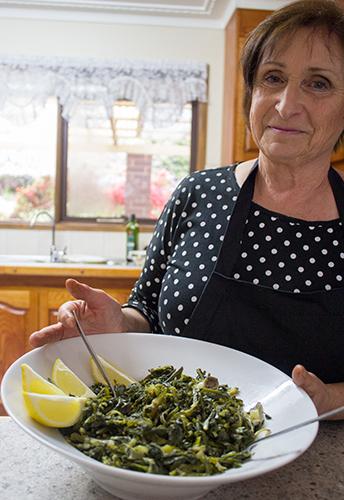
I was lucky to share a meal of Cosce Vecchie, homemade woodfired bread topped with olive oil, home-dried oregano and salt, Mary’s mother’s eggplant parmigiana and slices of fresh prosciutto with her and her husband Joe, when I called around to learn to cook dandelions.
Mary picks the nice tender greens. To pick the dandelion, she puts a knife under the flat weed and slides it across. She removes any dead or yellow leaves and you don’t eat the yellow flower stalks. You will have to wash thoroughly before use.
Cosce Vecchie (Dandelion Greens)
Bring a large pot of water to the boil. Add salt and the greens, pushing them down with a wooden spoon until they are all submerged under the water
When the leaves are tender, drain in a colander and press down firmly with a potato masher or small saucer to remove the excess water. Place in a large bowl and cut roughly with kitchen scissors. Loosen with a fork.
Place on a serving dish. Drizzle with olive oil, season with salt. A squeeze of lemon juice finishes it off nicely.
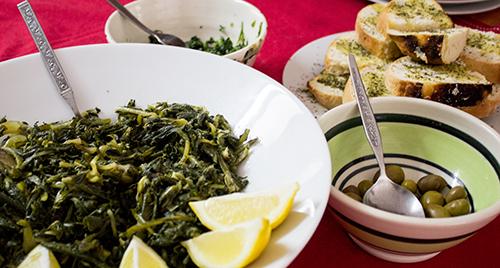
You can find this recipe in Nonna's Secret Recipe Book, part of the Mirboo North Italian Festa

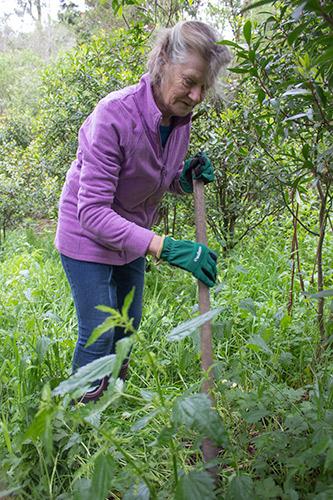
Recently, I spent a morning with Leonie from Brushtail Bush foods. A Boolarra farm growing and suppling native Australian herbs to restaurants and wholesales, fresh and dried.
Walking around her property, which she farms with her partner Terry, there are rambling paddocks of Strawberry gum, native thyme, beds of rive mint and pepper berry. Living outside of town, Leonie and Terry live largely off what they produce and grow around them.
On this day, Leonie shared her recipe for yogurt bread with stinging nettle.
Stinging nettles, Urtica dioica, have stinging hairs on them called trichomes, which will irritate your skin if you touch them. I know I still have an itchy finger from this morning. You need to wear gloves when handling them and soak the stems in a bowl of boiling water before use. The boil water removing the stinging chemicals from the plant.
The soaking liquid can be used as a tea with honey. Leonie uses it in a hot bath. It is said to be useful for inflammation or skin ailments. Stinging nettles are known as the “cure-all” weed.
Yogurt bread with stinging nettle
Ingredients
500 g of self-raising flour
one teaspoon of salt
500g of Greek yogurt
extra flour for dusting
one bunch of Stan needles
Use gloves when handling because if you don’t, you will get stung.
- Remove the leaves from stinging nettle and soak them in a bowl of boiling water for a few minutes. Strain then chop finely
- Combine flour, salt, and yogurt with blanch stinging nettles. Mix to form a dough.
- Turn out on a lightly floured surface and knead until smooth. Divide dough into approximately 10 balls. Roll each ball of dough into a flat into a 1 cm thick disk.
- Placed on a tray cover with a damp tea towel to stop them from drying out.
- Heat a lightly greased griddle pan (or you can use a sandwich press) and cook until golden and risen.

A little while ago, I was lucky to share a meal with Nadine from Wattlebank park farm.
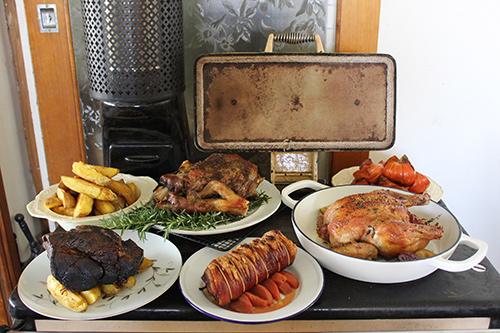
Nadine is the owner and operator, let just call her the farmer, of Wattlebank Park farm, located at St Clair, about halfway between Inverloch and Wonthaggi. A mixed farm of dairy, beef, pork, and lamb, Nadine produces a way range of meats and small goods that she sells through her farm gate butchers shop and at many of the local farmers' markets. In a collaboration with Prom Country Cheese, she produces a range of cow’s milk cheese.
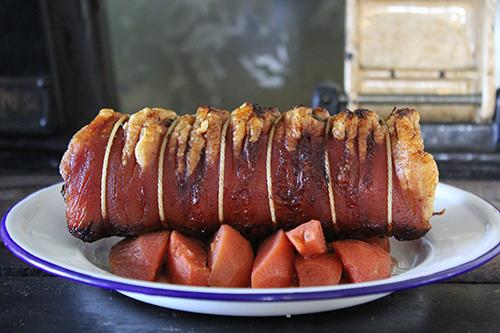
As you all know that I like to buy direct, where I can, from the farmer and as Wattlebank Park farm offers the whole range, it is one of my first go to shops for beef, pork, lamb and small goods. Nadine makes the best ‘Polish Sausage’ you have tasted. You can find her polish sausage atop many of the wood-fired pizzas, made and served locally.
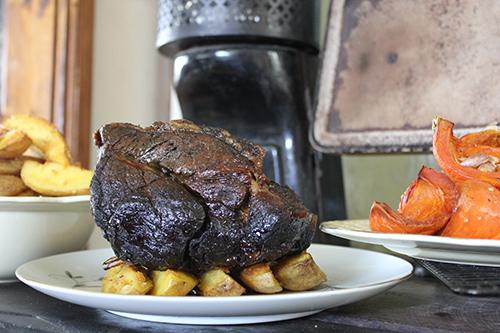
Not only is Nadine a farmer, and businesswomen, she is a fantastic cook. The day I visited, she was up earlier, stoking ‘Betty the Rayburn’ to slow roast my meal. Her delicious serving of slow cooked lamb, cooked through chicken, melting in the mouth beef and crackle, yes, the crackle crackled, roasted pork, made me want to return to the kitchen and cook up a winter roast feast!

You can find the full version of this article, along with Nadine's recipes in the Winter 2018 issue of Gippsland Country Life Style magazine.
Subcategories
Acknowledgment of country
Hello, I’m Jaci Hicken, from the lands of the Brataualung clan, which is where I’ve spent most of my life.
I would like to acknowledge all of us here today to cook together and share a meal.
I love sharing my dream of growing the food this country has to offer and share it with you.
The traditional place that we come together today is on the lands Gunaikurnai people
And I’d like to pay my respects to our elders past, present, emerging leaders, along with all the young people in our community.
